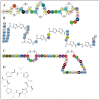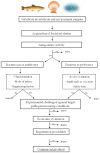Bacteriocin as weapons in the marine animal-associated bacteria warfare: inventory and potential applications as an aquaculture probiotic
- PMID: 20479972
- PMCID: PMC2866480
- DOI: 10.3390/md8041153
Bacteriocin as weapons in the marine animal-associated bacteria warfare: inventory and potential applications as an aquaculture probiotic
Abstract
As the association of marine animals with bacteria has become more commonly recognized, researchers have increasingly questioned whether these animals actually produce many of the bioactive compounds originally isolated from them. Bacteriocins, ribosomally synthesized antibiotic peptides, constitute one of the most potent weapons to fight against pathogen infections. Indeed, bacteriocinogenic bacteria may prevent pathogen dissemination by occupying the same ecological niche. Bacteriocinogenic strains associated with marine animals are a relevant source for isolation of probiotics. This review draws up an inventory of the marine bacteriocinogenic strains isolated from animal-associated microbial communities, known to date. Bacteriocin-like inhibitory substances (BLIS) and fully-characterized bacteriocins are described. Finally, their applications as probiotics in aquaculture are discussed.
Keywords: BLIS; aquaculture; bacteriocin; probiotic.
Figures



References
-
- Kurath G. Biotechnology and DNA vaccines for aquatic animals. Rev Sci Tech Off Int Epiz. 2008;27:175–196. - PubMed
-
- Toranzo AE, Magariños B, Romalde JL. A review of the main bacterial fish diseases in mariculture systems. Aquaculture. 2005;246:37–61.
-
- Austin B, Zhang XH. Vibrio harveyi: a significant pathogen of marine vertebrates and invertebrates. Lett Appl Microbiol. 2006;43:119–124. - PubMed
-
- Paillard C, Le Roux F, Borrego JJ. Bacterial disease in marine bivalves, a review of recent studies: Trends and evolution. Aquat Living Res. 2004;17:477–498.
-
- Marcogliese D. The impact of climate change on the parasites and infectious diseases of aquatic animals. Rev Sci Tech Off Int Epiz. 2008;27:467–484. - PubMed
Publication types
MeSH terms
Substances
LinkOut - more resources
Full Text Sources
Other Literature Sources
Medical
Molecular Biology Databases
Research Materials
